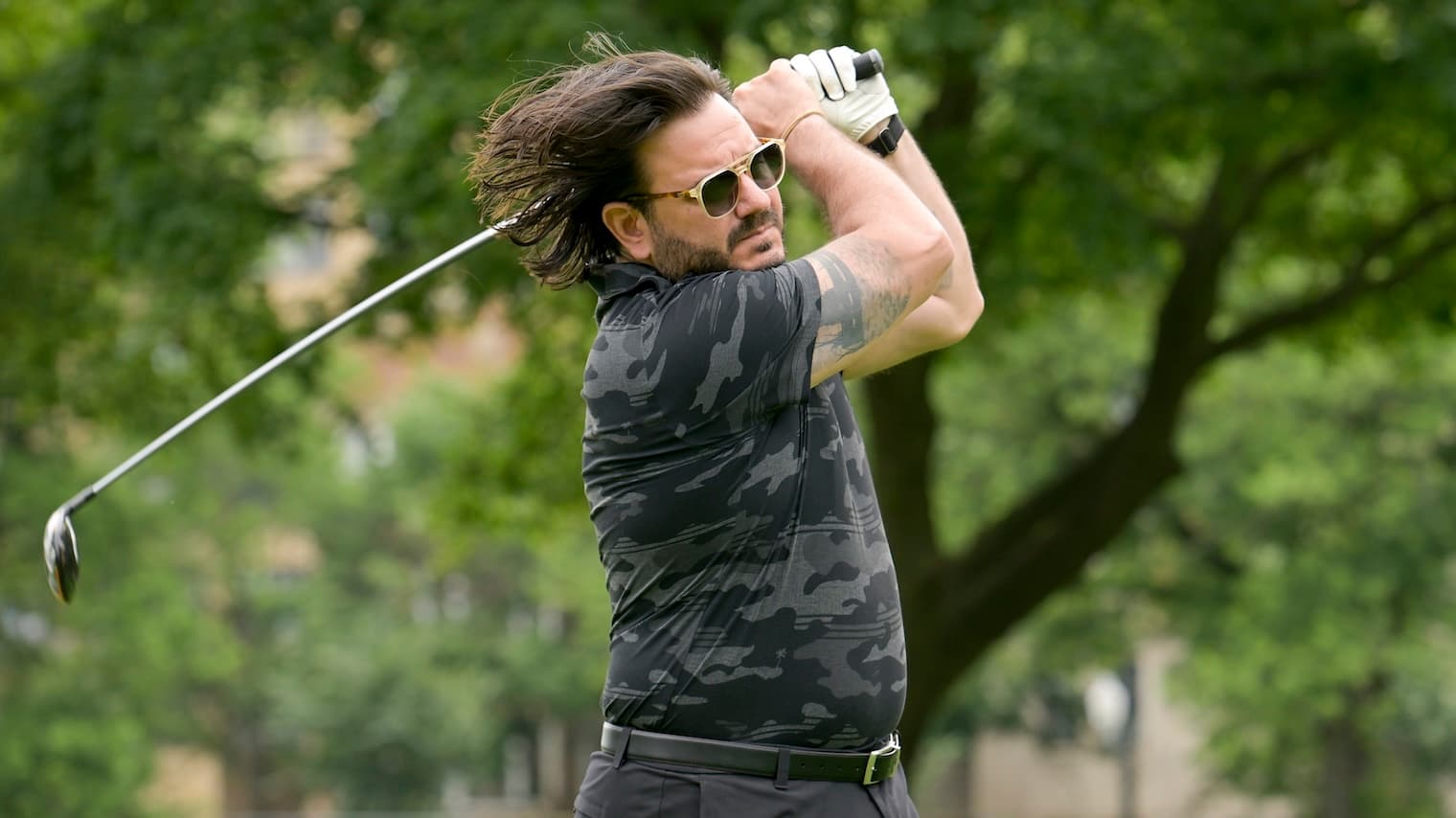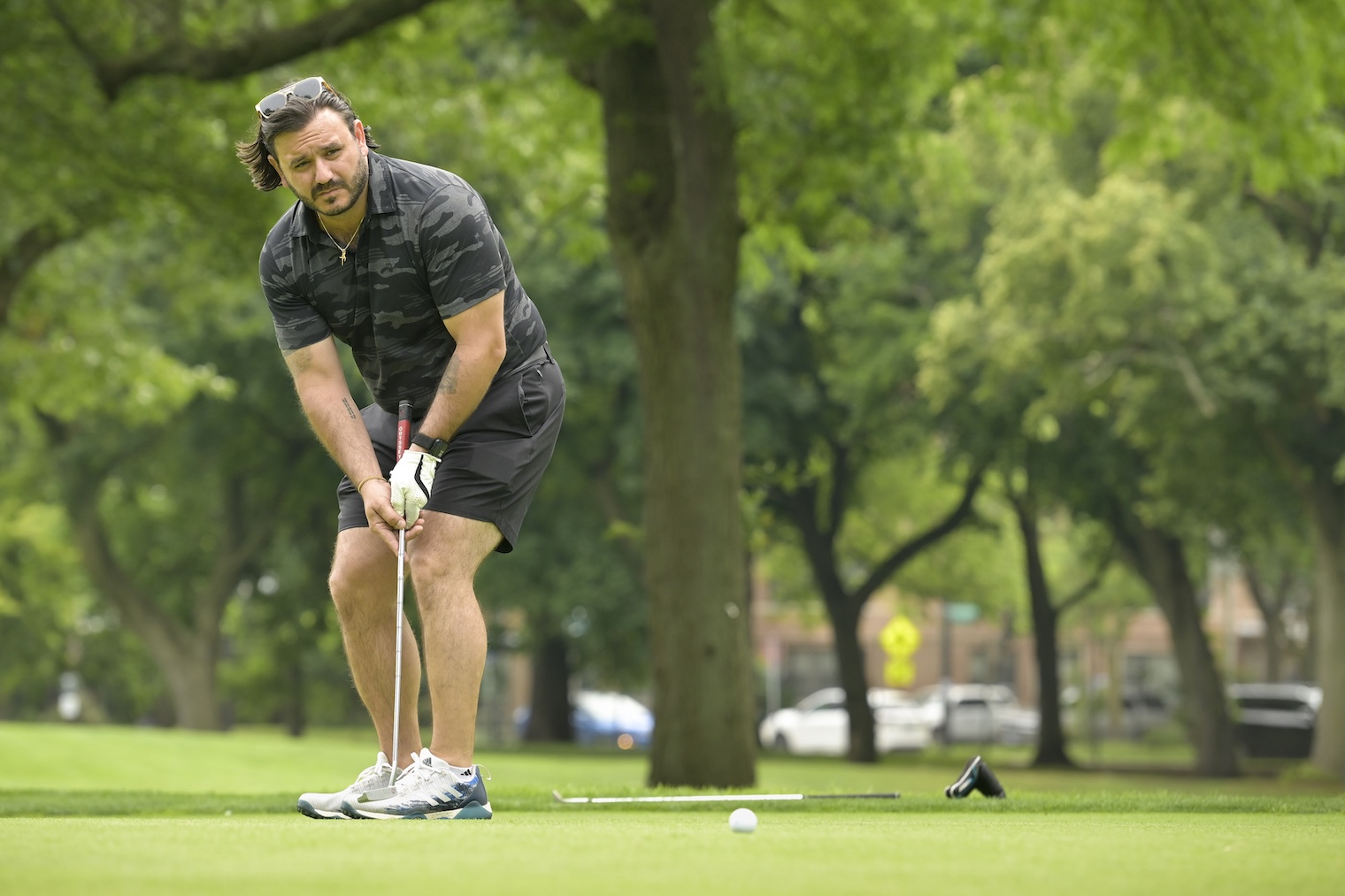How a 45-minute back surgery helped golfer avoid spinal fusion — and get his life back

The stabbing pain in Jonathan Boulahanis’ back came on suddenly. After swinging his golf club on the fairway last September, the 41-year-old crumpled to one knee.
“I just completely locked up,” said Boulahanis, a corporate attorney from Chicago.
Boulahanis had dealt with back pain in the past. He played football in high school and college and also lifted weights. His adult years were marked by years of episodic lower back and sciatic pain that increased in duration and frequency.
But the agony he felt after a routine golf swing was different.
“The idea of getting back up from that one knee was horrifying to me,” said Boulahanis, who managed to hobble home and start a specialized physical therapy regime to treat the resulting numbness in his right leg and foot.
During this time, he met with several doctors, including University of Chicago Medicine orthopaedic spine surgeon Michael Lee, MD.
Lee suspected nerve root irritation — possibly from a herniated disc in Boulahanis’ lower back — was causing the radiating pain and numbness that eventually spread to both legs and feet.
Finding the right herniated disc treatment
A herniated disc occurs when one of the gel-like cushions between the vertebrae (the bones that stack to make the spine) slips out through a tear in the disc’s rubbery exterior, which then puts pressure on the nerves in the spine.
Treatments for a herniated disc include lifestyle changes, physical therapy and medication, with surgery often considered a last resort.
Finding a solution for Boulahanis took some detective work.
“It was a tricky situation because the disc herniation was pretty mild-appearing on the MRI,” Lee said. “It wasn't clear this was the cause of his pain based on his distribution of pain, severity of pain and the MRI appearance.”
Boulahanis first tried mechanical diagnosis therapy, a type of rehabilitation for spine and disc problems, as well as two steroid injections near his tailbone. Neither option brought much relief.
He also took pregabalin, a nerve pain medication, but noted “the side effects were just too much for me to be able to perform in my career — just kind of falling asleep and being tired all the time wasn't going to work for me.”
The injury also affected his mental health. Boulahanis wasn’t able to enjoy working out, traveling and outdoor activity. He even hired a dog walker and canceled work trips due to pain.
“There were a lot of times where I just felt like giving up on trying to fix my back,” Boulahanis said.
Second opinion for back pain
Some physicians had previously recommended that Boulahanis continue conservative treatment because MRIs did not reveal severe or alarming abnormalities in his spine.
And one surgeon at a different Chicago hospital recommended extensive surgery that would remove the disc and fuse Boulahanis' L5 and S1 vertebrae together with screws and rods along the spine.
Boulahanis was hesitant. He was also concerned about permanently losing any mobility in his back or needing the fusion to be expanded years later.
After a thorough evaluation, Lee proposed a less-invasive option: surgically removing anything that might be pressing against the roots of the nerves likely causing leg numbness.
Lee is part of UChicago Medicine’s Comprehensive Spine Center, which combines the expertise of neurosurgeons and orthopaedic surgeons. The center offers sophisticated stereotactic techniques — some of which were developed at UChicago Medicine — to help pinpoint the exact location of spine pain or other abnormalities.

Less-invasive spine surgery
Still, there was no guarantee that this approach, a microdiscectomy, would relieve the symptoms.
“Clear communication with the patient is extremely important prior to any surgery,” Lee said. “Jonathan and I had multiple discussions about the risks and benefits, goals, likelihood of success or complication and alignment of expectations.”
The success rate of microdiscectomies improving leg symptoms is normally as high as 80% to 95%. In Jonathan’s case, however, the odds seemed much lower because of the mild MRI findings and unusual symptoms.
Boulahanis opted to proceed, and the operation took roughly 45 minutes in March. Lee performed a lumbar laminotomy and microdiscectomy on the L4 to S1 levels through a small incision in Boulahanis' back.
“I shaved off some of the bone in the area of the nerves to examine the nerve and assess whether any surrounding tissue was irritating them in some way that couldn’t be seen on the MRI,” Lee said. “Then, I removed part of the disc tissue that was slightly irritating the nerve.”
Active life after back surgery
Despite feeling some discomfort after surgery, Boulahanis made sure to walk, as Lee directed. With the pain and numbness in his leg and foot finally gone, he returned to work after three weeks.
He checked in with Lee at the six-week mark feeling better than he had in a decade.
“The results far exceeded my expectations,” Boulahanis said.
In June, four months after surgery, Boulahanis stepped back on to the golf course. He was at first a little timid with his swings, but he eventually settled in to his game as he gained confidence in how his back felt.
“Once I became confident that I wouldn’t have sciatic pain during my swing, I started to feel really good.” Boulahanis said. “Even better, I felt no pain the next day.”

Michael Lee MD
An expert spine surgeon, Michael Lee, MD, treats spinal injuries, degenerative conditions and spinal deformity as well as complex tumors of the spinal cord.
Learn more about Dr. LeeSpine Care
The University of Chicago Medicine spine team offers a wide range of non-surgical, minimally invasive and traditional proven surgical techniques for the treatment of back and neck problems.
Read more about our spine services